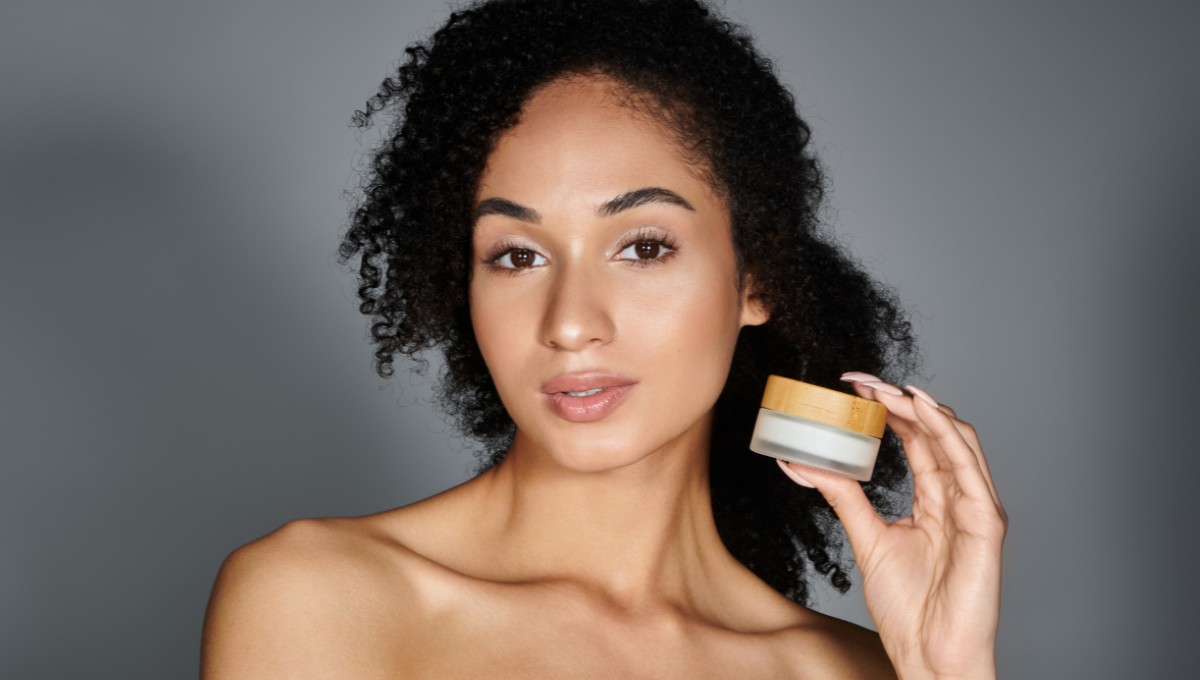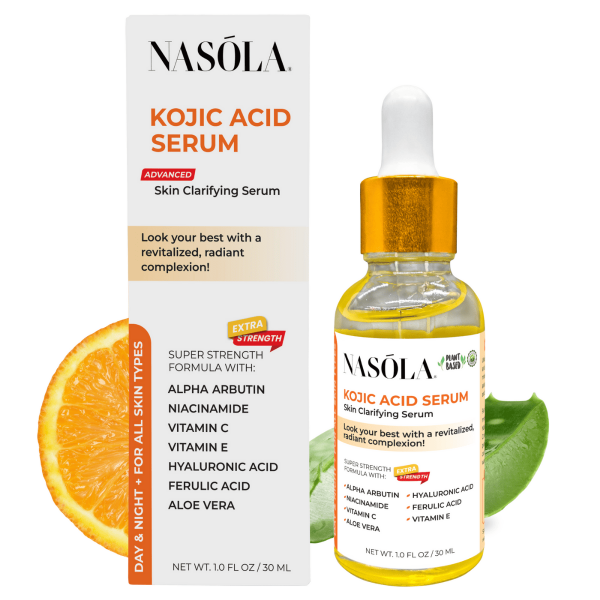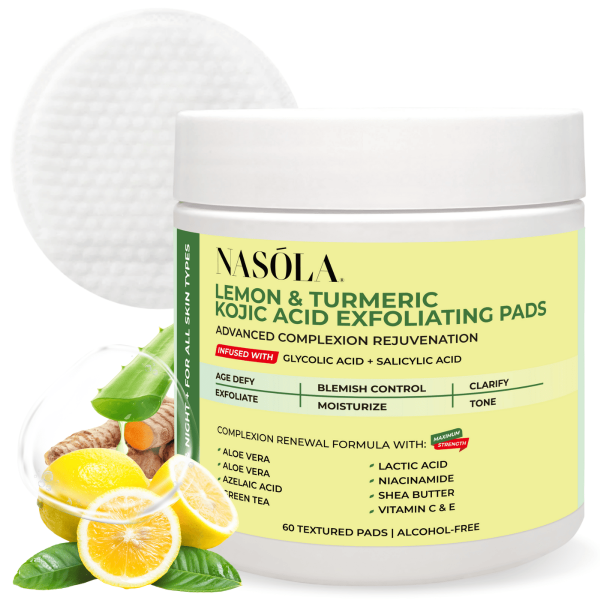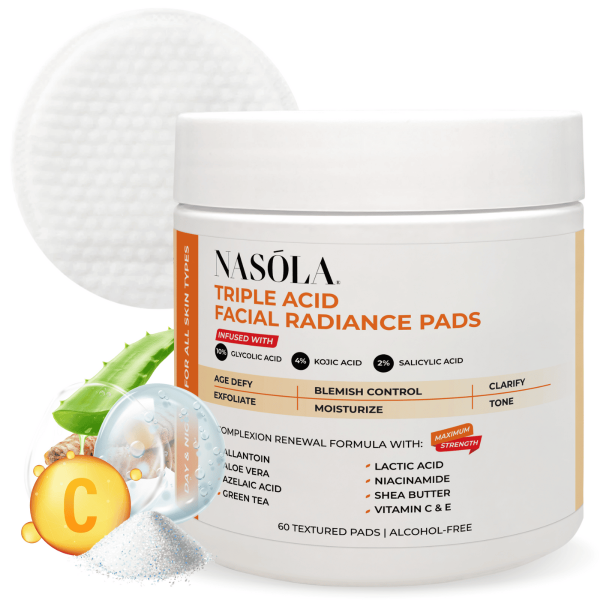Everyone’s skin tells a story. Maybe yours speaks with freckles from beach trips past, or leftover shadows from a breakout that overstayed its welcome. Whatever the case, chances are you’ve Googled “skin whitening cream” at least once, hoping to even out your skin tone or fade a stubborn spot — fast.
The good news?
You’re not alone on this journey — and even better, you’ve got options! With the rise of gentle brightening agents like kojic acid, exfoliating pads enriched with acids, and targeted serums, achieving luminous, even-toned skin no longer feels like chasing a skincare unicorn.
We’ll talk about the best options out there (including personal favorites like the Nasola Kojic Acid Cream and Serum). This guide will walk you through how skin whitening creams work, what ingredients to look for, and how to get glowing safely and effectively.
So, if you’re feeling a little fed up with dark spots stealing your spotlight…
Let’s fix that.
- What Is a Skin Whitening Cream and How Does It Work?
- Best Skin Whitening Cream Ingredients to Watch For
- Best Skin Whitening Cream for Targeted Dark Spots
- How to Incorporate Skin Whitening Cream Into Your Daily Routine
- Exfoliation and Whitening: Why Dead Skin Might Be Dulling Your Glow
- Skin Whitening Cream Longevity: What to Expect and How to Maximize Results
- Can All Skin Types Use Skin Whitening Creams?
- How to Choose a Safe Skin Whitening Cream for Long-Term Use
- Top Skin Whitening Mistakes to Avoid
- Conclusion
- Frequently Asked Questions
What Is a Skin Whitening Cream and How Does It Work?
The skincare aisle has a lot going on — and sometimes it feels like every jar promises to change your life. But let’s clear the clutter and talk specifically about a skin whitening cream.
These creams are formulated to gradually fade dark spots, reduce hyperpigmentation, and balance uneven tone. They don’t “bleach” the skin (big myth!). Instead, they help regulate melanin production — the natural pigment giving your skin its color.
Key ingredients like kojic acid, Vitamin C, and AHAs are the MVPs here. Kojic acid works by blocking the production of tyrosine, an amino acid needed for melanin formation. Vitamin C?
It’s a brightening powerhouse that fights free radicals AND fades discoloration. AHAs like glycolic acid gently exfoliate to remove dull, pigmented skin cells and boost product absorption.
Here’s what makes these creams truly work:
- They reduce melanin production for a more even tone.
- They fade acne scars, sun spots, and age spots over time.
- They often include exfoliants, speeding up cell turnover.
- They can improve texture, not just tone.
Commitment is key though — these aren’t overnight miracles. But… give it a few weeks, and your mirror just might love you back a little more.
Types of Hyperpigmentation Skin Whitening Creams Can Address
Skin whitening creams can target multiple pigmentation issues when used consistently. Whether it’s sun-induced spots from tanning or old blemish scars, they get the job done.
How Long Until You See Results?
Generally, results can begin to show in two to four weeks when used as directed. But optimal, long-term improvements (especially for deep pigmentation) may take up to 8 weeks.
Best Skin Whitening Cream Ingredients to Watch For
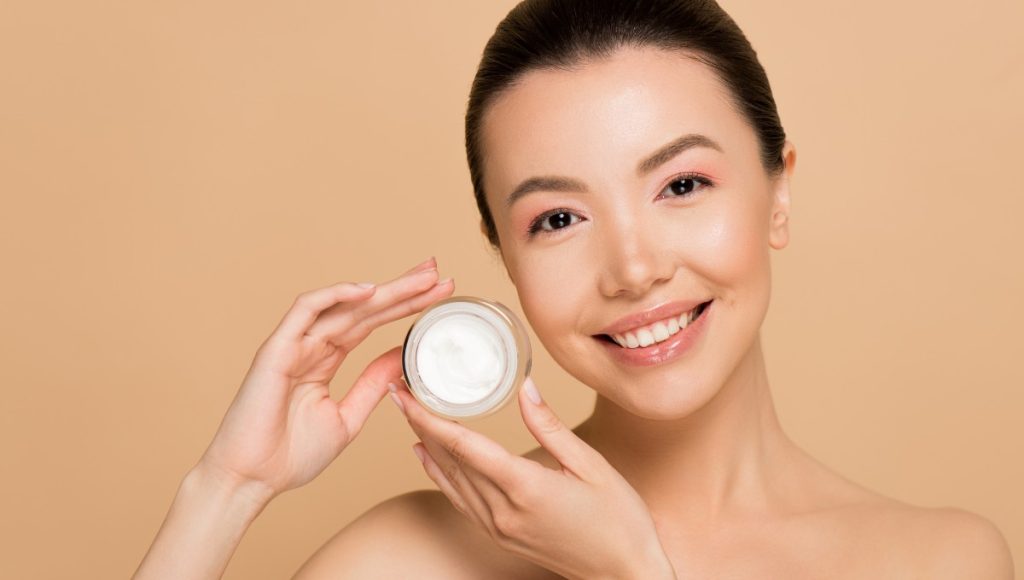
Not all brightening ingredients are created equal — and stacking the wrong ones can lead to irritation instead of illumination. Here’s what to look for when scanning the label of the best skin whitening cream:
Kojic Acid
This naturally derived ingredient gets straight to the point: targeting melanin production and fading dark spots like a pro. It’s non-abrasive but works deeply.
Product Spotlight: The Nasola Kojic Acid Cream combines kojic acid with a silky, fast-absorbing base that melts into the skin. This cream is a game-changer if you’re looking for noticeable results without the harshness.
Apply it consistently to fade stubborn pigmentation and boost your skin’s clarity.
Why we love it?
- Lightweight texture, suitable for all skin types
- Helps fade acne scars and age-related discoloration
- Safe for daily use
- Pairs beautifully with exfoliants for enhanced results
Vitamin C
Ah, Vitamin C — the superstar. This antioxidant does more than brighten. It protects against environmental oxidative stress (hello, pollution and UV), boosts collagen, and supports an even skin tone.
When used consistently, it can:
- Fade dark spots
- Prevent new discoloration
- Improve skin firmness
- Add overall glow
Glycolic Acid
A classic exfoliating AHA, glycolic acid helps remove surface-level dead skin cells and allows your brightening cream to penetrate deeper.
It’s known to:
- Unclog pores gently
- Smooth fine lines
- Improve skin texture
- Boost cell turnover
Turmeric
Great for sensitive skin? Yes, please. Turmeric isn’t just a color pop in your latte—it’s anti-inflammatory, antibacterial, and naturally brightening. It calms redness while lightening pigmentation with consistent use.
Best Skin Whitening Cream for Targeted Dark Spots
Let’s face it. Not all dark spots are created equal. Some fade fast, while others cling to your skin like a bad habit.
When you’re dealing with stubborn, targeted areas — say that one annoying sun spot on your cheek — you need strategic products with double-duty exfoliation and brightening.
Deep Discoloration Needs Deeper Exfoliation
Surface-level treatments won’t cut it with deep acne scars or melasma patches. That’s where AHA/BHA combos swoop in.
Product Pick: The Nasola Triple Acid Facial Radiance Pads are a ride-or-die essential. Packed with glycolic, lactic, and salicylic acids, these handy pads gently resurface the skin, unclog pores, and prep your face for a whitening cream to do its magic.
Why they’re worth it?
- Convenient, single-use pads
- Unclogs and exfoliates
- Boosts glow and tone
- Strengthens your whitening routine
Why Complementing Creams with Acids Makes a Difference
Pairing your skin whitening cream with exfoliating acids enhances absorption tenfold. When dead skin cells stay packed on your surface, the active ingredients can’t make it through.
How to Incorporate Skin Whitening Cream Into Your Daily Routine
You’ve got the products — now what? A brightening bombshell routine won’t work if it’s all over the place. Consistency and sequence are your new best friends. Trust me, your skincare routine doesn’t need to be fancy, just smart.
AM Routine: Simple But Effective
- Cleanse: Start with a gentle cleanser to clear skin.
- Serum: A light Kojic Acid or Vitamin C serum preps your skin.
- Cream: Apply your skin whitening cream evenly.
- SPF: Non-negotiable! At least SPF 30 every. single. day.
Try This: Pair your day routine with the Nasola Kojic Acid Serum. This light serum penetrates deeper before you layer your brightening cream. It boosts speedy results and works without clogging pores.
Reasons to love it:
- Enhances kojic acid cream efficacy
- Lightweight for layering
- Improves radiance over time
- Helps reduce pigmentation quicker
PM Routine: Time for Repair
- Cleanse: Remove makeup and daily grime.
- Exfoliate: 2–3x/week use exfoliating pads.
- Cream: Apply your skin whitening cream evenly.
- Moisturize: Follow with soothing hydration.
Sticking to this will do more than fix dark spots…
It can seriously transform your confidence.
Exfoliation and Whitening: Why Dead Skin Might Be Dulling Your Glow
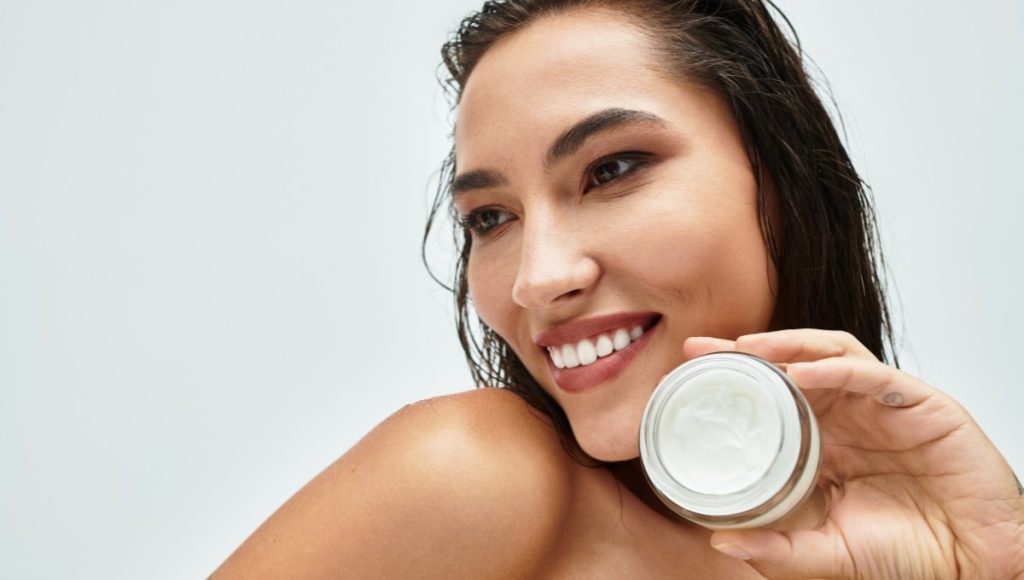
If your skin could sigh, it probably would after a good exfoliation. SO many people overlook this step — but dead skin buildup is like trying to water your lawn through a tarp. Remove it, and everything thrives.
Physical vs. Chemical Exfoliation: Pros and Cons
Physical exfoliants (like scrubs) can feel satisfying, but often cause microtears in sensitive skin. Chemical exfoliants use acids to dissolve dead cells more gently.
The Better Option? For whitening, chemical is the way to go.
- Less abrasive
- Better for acne-prone or sensitive skin
- Evens tone more effectively
- Doesn’t aggravate active breakouts
How Often Should You Exfoliate for Skin Whitening Results?
Don’t go overboard — 2 to 3 times per week is the sweet spot. Too much can damage your barrier and delay results. Be consistent and follow with soothing steps.
Product to Try: The Nasola Lemon + Turmeric Kojic Acid Exfoliating Pads offer a triple-threat combo: they lightly exfoliate, brighten, AND calm inflammation. Perfect for sensitive skin scared of stronger acids.
Skin Whitening Cream Longevity: What to Expect and How to Maximize Results
So, how long till you see a change?
Typically, visible changes start at 2–4 weeks. But deeper pigmentation requires 6–8 weeks and ongoing maintenance. The trick is consistency, protection from the sun, and pairing your cream with supporting products.
To maintain those results:
- Avoid tanning and direct sunlight
- Always use SPF 30 or higher (yes, even indoors!)
- Exfoliate to keep flakes away
- Moisturize to protect your skin barrier
Pro tip? Don’t expect miracles by week one. But stay consistent, and your before & afters will speak loud.
Can All Skin Types Use Skin Whitening Creams?
You bet — but that doesn’t mean one formula fits all. Oily, dry, and sensitive skin types absorb actives differently. Let’s break it down real quick.
Best Practices for Sensitive Skin Users
Sensitive skin gets alarmed easily, so avoid formulas packed with heavy fragrances or alcohol. Stick to natural agents like kojic acid and turmeric.
Patch test always.
- Start with once daily use
- Watch for redness or tingling
- Keep your barrier strong with moisturizer
- Pair with calming actives like aloe or niacinamide
Non-comedogenic Formulas for Oily Skin
Oily skin still needs moisture and targeted treatment. Opt for gel or light cream formats that won’t block pores.
Key Tips:
- Use gel-based serums
- Layer lightweight creams
- Look for “non-comedogenic” on the label
- Double cleanse at night
How to Choose a Safe Skin Whitening Cream for Long-Term Use
There’s no permanent fix in skincare, but safety is everything. You don’t want a whitening hit that hurts long term. Choose wisely…
Check for Clinical-Backed Ingredients
Always read the ingredient list.
- Look for tested agents like kojic acid, glycolic acid, and niacinamide
- Avoid hydroquinone unless prescribed
- Skip artificial fragrances if you’re sensitive
- Choose brands with transparency
Know Your Goals and Choose Accordingly
What are you trying to fix?
- Age spots? Use combo exfoliating pads + cream.
- Dull glow? Focus on serums + Vitamin C.
- Melasma? Pair products and be patient.
Understand the why — then pick what supports it.
Top Skin Whitening Mistakes to Avoid
More product ≠ faster results. Truthfully, some mistakes actually slow your skin down.
Mistake #1: Skipping SPF
If you’re brightening without sunscreen, it’s like bailing water with a holey bucket. UV exposure will reverse all progress.
Mistake #2: Overusing Exfoliants
Too much exfoliating strips your skin and worsens pigmentation. Stick to 2–3 times per week and moisturize after.
Conclusion
Choosing the right skin whitening cream is more than picking a pretty jar off the shelf — it’s knowing your skin, your concerns, and what ingredients really work. The best skin whitening cream formulations use active ingredients like kojic acid and glycolic acid without irritating your skin.
From the hydrating Nasola Kojic Acid Cream to the exfoliating pads and serums designed to enhance results — your next glow-up is totally doable. And yes — it’s okay to want more from your skin without guilt.
✨ Ready to get started? Check out Nasola’s brightening collection and let your natural glow speak louder than your filters.
Frequently Asked Questions
The Nasola Kojic Acid Cream is highly effective for treating hyperpigmentation. Powered by kojic acid, it targets the melanin production process directly. With regular use, it helps fade age spots, acne scars, and melasma.
Yes, using skin whitening creams like those with kojic acid is safe for daily use. However, always follow up with SPF in the morning to prevent sun damage and ensure the active ingredients work effectively.
Usually, visible results appear within 2–4 weeks, but deeper discoloration like melasma can take up to 8 weeks. The key is consistency and pairing it with complementary products like serums and exfoliants.
Absolutely! The Nasola Triple Acid Facial Radiance Pads are perfect to use 2-3 times per week. They prep the skin by removing dead cells, allowing deeper absorption of your whitening cream.
Yes — as long as they include gentle ingredients like turmeric and kojic acid. The Nasola Lemon + Turmeric Kojic Acid Exfoliating Pads are great for sensitive skin, offering calming action while exfoliating.
Avoid creams with hydroquinone unless prescribed, as prolonged use can have side effects. Also stay away from heavily perfumed or alcohol-based formulas, especially if you have sensitive skin.
Yes! Skin whitening creams work for all genders. Men dealing with acne scars or sun spots can benefit from daily use. Just ensure the formulation suits your skin type.
Yes, but shift to maintenance. Reduce frequency and focus on sun protection and gentle exfoliation. Products like the Nasola Kojic Acid Serum help maintain clarity.
Not directly. While it can improve overall tone, whitening creams don’t treat the texture of stretch marks. Look for products with retinol or peptides for that purpose.
No — they help balance your natural skin tone by treating excess pigment, not removing your base color. It’s about glow, not transformation.

